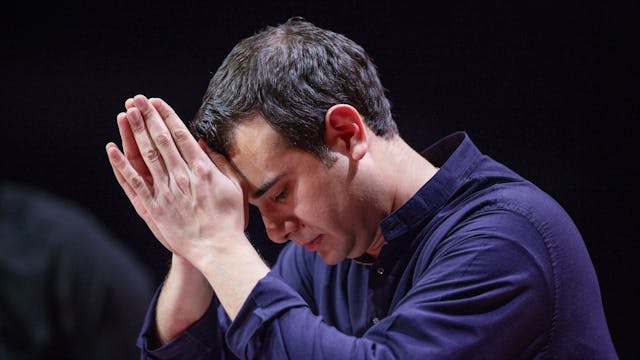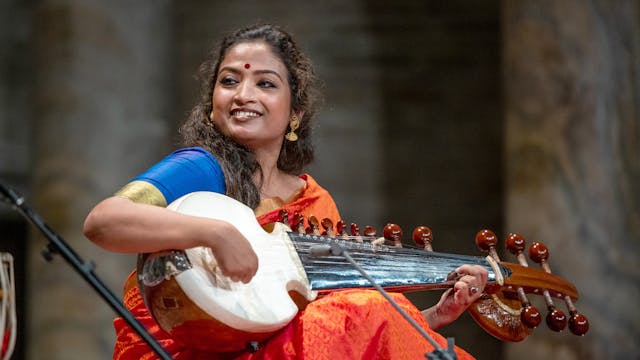Ustad Shahid Parvez | Bhairavi
Hindustani Instrumental
•
17m
Recorded at Darbar Festival 2007, on 15th April, at the Phoenix Theatre Leicester.
Musicians:
- Ustad Shahid Parvez (sitar)
- Pandit Yogesh Samsi (tabla)
- Debipriya Das (tanpura)
Raag Bhairavi; Thaat: Bhairavi; Samay: Morning
Parvez’s portrayal of Bhairavi is deeply profound; In this piece from the Darbar Festival 2007, he concludes his recital with this composition set to a rhythmic cycle of 6 beats (Dadra). Pandit Yogesh Samsi gives a mellowed accompaniment on the tabla, suited against the devotional mood and pathos that is portrayed through Bhairavi on the sitar.
Ustad Parvez’s applies elongated meends to the introductory phrases painting a calming mood. Picking up on the composition, he uses delicate embellishments enhancing the effect of this light, final rendition of his concert.
Pandit Samsi calibrates his accompaniment to the dulcet portrayal of Bhairavi, never for once trespassing the melodic scheme laid by Ustad Parvez. This is one of the best recitals of Bhairavi in Darbar’s history, which is what makes it so exciting for us to bring this to you in the most superior quality audio and visual processing of an Indian classical concert.
Bhairavi is often described as the ‘queen of ragas’. It takes its name from the Hindu goddess of destruction, and conjures versatile moods. To some it can evoke ‘awe, terror, and chaos’; to others ‘a pleasant sobering atmosphere of love and piety’. It is played at sunrise, or alternatively as the final piece in a concert. Understanding the raga in depth is crucial to Hindustani learning - bansuri master Rupak Kulkarni recounts the approach of his guru Hariprasad Chaurasia: “Guruji taught me Raag Bhairavi for five years. When I complained about the repetition, he said: ‘You have to practice Bhairavi until your last breath’. That is what made me realize what swarabhyas [the study of notes] means”.
It is based on the form SrgmPdnS - all swaras [notes] are komal [flattened] except Sa, Ma, and Pa, like the Western Phrygian scale or Carnatic Raga Hanumatodi. The vadi and samvadi (dominant and sub-dominant notes) are typically taken to be Ma and Sa. The raga commonly takes a versatile mishra (‘mixed’) form - all 12 notes are allowed, thus injecting some comparatively rare chromaticism into Hindustani music. Its flexibility is unmatched in the raga pantheon.
Up Next in Hindustani Instrumental
-
Alam Khan | Bhimpalasi
Recorded at Darbar Festival 2011, on 22nd April, at King's Place, London.
Musicians:
- Alam Khan (sarod)
- Anubrata Chatterjee (tabla)
- Debipriya Das (tanpura)Raag Bhimpalasi; Thaat: Kafi; Samay: Afternoon
Alam Khan’s portrayal of Raag Bhimpalasi takes an unassuming quality with the seren...
-
Debasmita Bhattacharya | Raag Jog
Recorded at Ravenna Festival, on 22nd June 2017, at Chiostri Francescani, Ravenna, Italy.
Musicians:
- Debasmita Bhattacharya (sarod)
- Patri Satish Kumar (mridangam)
- Ghatam Udupa (ghatam)Raag Jog, Thaat: Khamaj, Samay: Night
In an impromptu sitting in Italy, Debasmita Bhattacharya pla...
-
Ustad Shahid Parvez Khan | Raag Yaman
Recorded at Darbar Festival 2018, on 28th October, at the Barbican Theatre, London.
Musicians:
- Ustad Shahid Parvez Khan (sitar)
- Ojas Adhiya (tabla)Raag Yaman; Thaat: Kalyan; Samay: Evening
Watch the unparalleled sitar of Ustad Shahid Parvez Khan as he performs Raag Yaman at the 2018 Darba...



